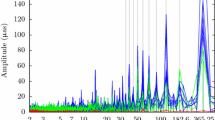Abstract
The final products of theCODE Analysis Center (Center for Orbit Determination in Europe) of theInternational GPS Service for Geodynamics (IGS) stem fromoverlapping 3-day-arcs. Until 31 December, 1994 these long arcs were computedfrom scratch, i.e. by processing three days of observations of about 40 stations (by mid 1995 about 60 stations were used) of the IGS Global Network in our parameter estimation program GPSEST. Becauseone-day-arcs have to be produced first (for the purpose of error detection etc.) the actual procedure was rather time-consuming.
In the present article we develop the mathematical tools necessary to form long arcs based on the normal equation systems of consecutive short arcs (one-day-solutions in the case of CODE). The procedure in its simplest version is as follows:
-
Each short arc is described bysix initial conditions and a number of dynamical orbit parameters (e.g. radiation pressure parameters). The resulting long arc in turn shall be based onn consecutive short arcs and described bysix initial conditions and again the same number of dynamical parameters as in the short arcs..
-
By asking position and velocity to be continuous at the boundaries of the short arcs we obtain a long arc which is actually defined by one set of initial conditions andn sets of dynamical parameters (ifn short arcs are combined)..
-
By asking the dynamical parameters to be identical in consecutive short arcs, the resulting long arc is characterized by exactly the same number of orbit parameters as each of the short arcs.
-
This procedure isnot yet optimized becauseformally all n sets of orbit parameters have to be set up and solved for in the long arc solution (although they are not independent).
In order to allow for an optimized solution we derive all necessary relations to eliminate the unnecessary parameters in the combination. Each long arc is characterized by the actual number of independent orbit parameters. The resulting procedure isvery efficient.
From the point of view of the result the new procedure iscompletely equivalent to an actual re-evaluation of all observations pertaining to the long arc. It is much more efficient and flexible, however because it allows us to construct 2-day-arcs, 3-day-arcs, etc. based on the previously stored daily normal equation systems without requiring much additional CPU time.
The theory is developed in the first four sections. Technical aspects are dealt with in appendices A and B. The actual implementation into the Bernese GPS Software system and test results are given in section 5.
Similar content being viewed by others
References
Beutler, G., E. Brockmann, W. Gurtner, U. Hugentobler, L. Mervart, M. Rothacher (1994a).Extended Orbit Modeling Techniques at the CODE Processing Center of the International GPS Service for Geodynamics (IGS): Theory and Initial Results., Manuscripta Geodaetica, Vol. 19, pp. 367–386.
Beutler, G., I.I. Mueller, R.E. Neilan (1994b).The International GPS Service for Geodynamics (IGS): Development and Start of the Official Service on 1 January 1994., Bulletin Gódesique, Vol 68, No 1, pp. 43–51.
Beutler, G. (1991).Himmelsmechanik II: Der erdnahe Raum. Mitteilungen der Satelliten-Beobachtungsstation Zimmerwald, No. 28, Druckerei der Universität Bern.
Rothacher, M., G. Beutler, W. Gurtner, S. Botton, C. Boucher (1993).Results of the IGS Data Processing at the Center for Orbit Determination in Europe (CODE)., Proceedings of the 1993 IGS Workshop, pp. 133–144, Druckerei der Universität Bern.
Zumberge, J.F., D.C. Jefferson, M.B. Heflin, F.H. Webb (1994).Earth Orientation Results forom the Jet Propulsion Laboratory using GPS., IERS Technical Note 17, pp. P–43 — P47, P. Charlot editor, Observatoire de Paris, September 1994.
Author information
Authors and Affiliations
Rights and permissions
About this article
Cite this article
Beutler, G., Brockmann, E., Hugentobler, U. et al. Combining consecutive short arcs into long arcs for precise and efficient GPS Orbit Determination. Journal of Geodesy 70, 287–299 (1996). https://doi.org/10.1007/BF00867349
Received:
Accepted:
Issue Date:
DOI: https://doi.org/10.1007/BF00867349




